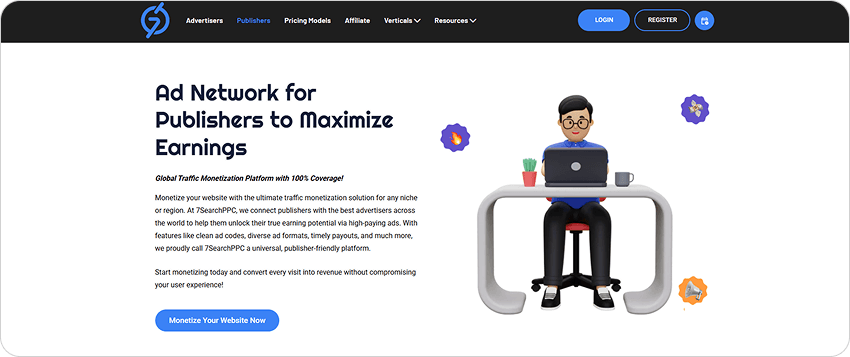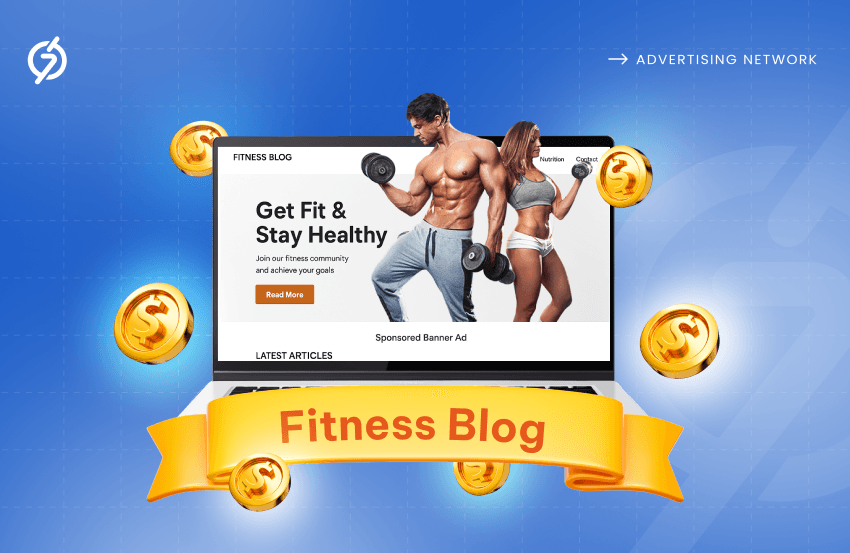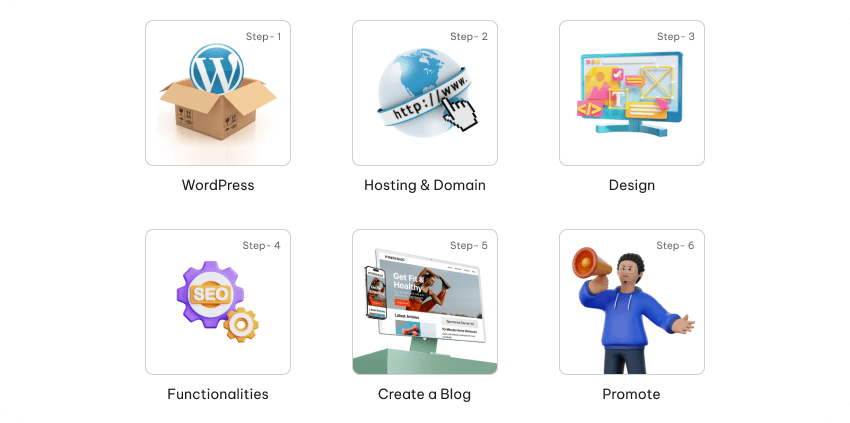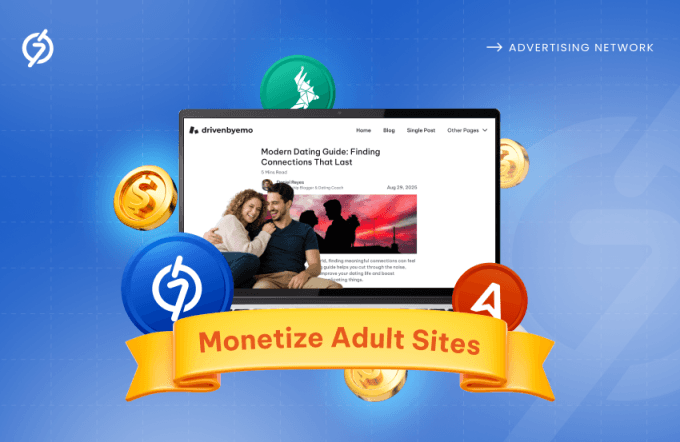Fitness blogging lets you share your own journey to help and inspire others towards a healthier life through your motivational messages, workouts, and nutritional tips. Whether you’re an athlete, a personal trainer, or a fitness addict, starting a fitness blog gives you wings to connect, share, and inspire.
Join us in this journey to learn how to start a fitness blog and generate a sustainable stream of income. To keep you motivated in your blogging venture and give you an amazing head start, we have also included some trending fitness blogging topics and niches.
Start Monetizing Your Fitness Blog!
Is Fitness Blogging Still a Profitable Niche?
There are several blogging niches, each of which demands in-depth knowledge, experience, expertise, and a unique perspective to represent ideas. The fitness blogging niche is one of them.
Fitness enthusiasts are seeking real fitness gurus and not AI fluff to help them create customized workout routines, nutritional diet plans, and provide personalized training.
So, if you’re planning to launch a fitness blogging website, you’re going in the right direction, as it’s one of the most demanding blogging niches and is projected to increase in the coming years.
Health and fitness blogging is a profitable niche, and it has several popular sub-niches you need to know as a soon-to-be fitness blogger.
Also Read: Most Profitable Blogging Niches for Publishers in 2025
Trending Health and Fitness Niches
The health and fitness industry is very broad, and if you don’t segment it, you can’t target a specific audience, establish yourself as an industry specialist, or monetize fitness blogs. Therefore, to become a successful fitness blogger, identify the sub-niches you want to target to achieve better results.
Some of the trending health and fitness sub-niches are listed below.
- Workout Routines
- Nutrition Advice
- Meditation
- Yoga Training
- Fitness for Remote Workers
- Postpartum Fitness
- Weight Loss Tips
- Bodybuilding and Strength Training
- Dietary Supplement
- Sports Performance Training
- Fitness Motivational Stories
- Fitness Product Reviews
Based on your interest and experience, choose your health and fitness sub-niches. Starting a fitness blog isn’t difficult; anyone can do it, but there are a few things you need to be aware of before starting a fitness blog. Ask yourself: do you know all the things mentioned below?
Things You Need to Know Before Starting Your Fitness Blog
Consider getting to know the following things before you proceed to create your fitness website, as it eases the process.
- Difference between WordPress.org and WordPress.com. If you’re starting a fitness blog using WordPress, you need to be familiar with the differences it holds.
- Benefits of your selected hosting provider. There are several hosting providers, each offering different functionalities and benefits. Consider finding out if they offer website maintenance and security services.
- Hosting you’re choosing. What hosting are you choosing —dedicated, shared, or cloud? This can significantly impact your website’s data and security.
- Know your ideal audience. You can’t create content that resonates with readers if you don’t know your target audience. Understand your audience and segment them accordingly to optimize your trending fitness blog topics.
- The design and content of your fitness website. How many pages do you want on your website? And how you want them to look?
- SEO techniques for better organic visibility. What SEO parameters are you going to use for your health and fitness blogs?
- Health and fitness blog content strategy. What topics are you going to cover? How are you going to interconnect them? How are you going to promote your fitness blogs?
Even though you don’t have all the answers, try to find them and consequently learn how to start a fitness blog. Let us now tell you how to build your fitness blogging website.
How to Start a Fitness Blog in 6 Easy Steps
Starting a fitness blog to share your personal fitness journey and inspire others to live a better, healthier life is truly amazing. Well, there are several website builders such as Wix, Shopify, and others.
But in this post, we’ll let you know how you can start a fitness blog using WordPress, as it’s the most popular CMS platform and covers more than 40% of the web.
1. Choose WordPress as Your Blogging Platform
WordPress is a popular CMS (Content Management System). Fitness bloggers can easily create, edit, delete, and publish content using the WordPress editor.
It offers exceptional flexibility, customization, and functionality. Website owners and fitness bloggers love WordPress because it empowers them to take full control over their website.
2. Select Hosting and Domain Name
Select a hosting provider to host your website on the internet and create a memorable and descriptive name that resonates with your website goals. Look for a hosting provider that offers different types of hosting along with 24/7 customer support, great performance, uptime, security, and an SSL certificate.
3. Design Fitness Blogging Website
Select a WordPress theme and customize it accordingly to give it the look and feel you want. Try creating a captivating fitness website that has a clean and simple design, is visually appealing, and has easy navigation. The WordPress theme directory has a wide range of free and premium themes to choose from.
4. Add Functionalities (optional)
Enhance your health and fitness website with extra functionalities through plugins. You can use SEO and social sharing plugins to increase organic visibility and reach of your fitness blogs.
Although you can add any functionality to your fitness website, it’s advisable to add only the plugins that are imperative to run the website, as it can slow down your website speed and expose vulnerabilities.
5. Create a Blog on Health and Fitness
Time to launch your first blog on health and fitness. Use the WordPress editor to create your fitness content. Don’t pick topics randomly; create your health and fitness categories to target the right content and keywords.
6. Promote Your Health and Fitness Blogs
Promote your workout tips, nutritional advice, personal stories, and motivational messages through social channels, guest blogging, and online forums. Not promoting your content is like intentionally restricting its reach within a set boundary. You need to reach your audience to increase visibility and drive traffic!
How to Monetize Fitness Blogs
Now that you know how to start a fitness blog, it’s time to uncover the monetization methods you can use to monetize your fitness blogs.
Use the following fitness blog monetization strategies to generate passive income from your blogging efforts.
1. Monetize Fitness Blogs Using Ads
One of the easiest ways to monetize is by putting ads on your fitness blogs. Sell your ad space to generate revenue from the impressions and clicks it drives. To do so, you can either pitch advertisers directly or connect with an ad network.
Connecting advertisers directly feels more chaotic as you’re restricted by their rules and regulations, confined to their selected ad format, and must wait for payouts.
Well, this is not the case with ad networks. Ad networks provide more flexibility, power, and control over your ad inventory. You choose which ad categories and format you want to place, where to place them, and for how long you want to keep the ads on your website. Letting you be the boss of your fitness blogging website.
All you’ve to do is create balanced ad monetization strategies to generate a sustainable stream of income and maintain users’ onsite experience.
For your health and fitness blog, you can connect with the 7SearchPPC ad network. 7SearchPPC is a popular ad network that enables bloggers and website owners to access various ad formats, receive bi-monthly payouts, and track impressions, clicks, and revenue through a clean and user-friendly dashboard.

Benefits of Using 7SearchPPC for Fitness Blog Monetization
Let’s explore some more benefits of using the 7SearchPPC ad network.
- Clean and safe ad codes that don’t disturb on-site users’ experience.
- High-paying rates with fast, secure, and timely payouts.
- Access to multiple payout options and view payment details.
- Filter and monitor data based on country-wise, device-wise, and other fields.
- It supports various ad formats, including text ads, native ads, banner ads, interstitial ads, popunder ads, and in-page push ads, catering to diverse website niches.
- 24/7 customer service to assist you with your queries.
Also Read: How to Create Fitness Ads That Perform? Ad Formats, Creatives, and Tips
2. Use Affiliate Marketing
Promote affiliate products and services and earn commission for every sale and conversion your affiliate link generates. Join affiliate programs of trusted sources to promote a wide range of health and fitness products, including fitness apparel, healthcare supplements, gadgets, fitness equipment, books, and guides.
3. Create Subscription Plans
Create paywall content for health and fitness blogs. Website owners can create different subscription tiers to make their subscription plan more accessible and convertible.
Fitness bloggers often provide Q/A sessions, product reviews, workout guides, nutritional meal recipes, remote workout videos, restaurant reviews, and in-depth, well-researched content in their fitness subscription plans.
4. Create Sponsored Content
Collaborate with reputable and trustworthy health and fitness brands to create sponsored blog posts and make money out of it. For instance, you can partner with brands to promote health and fitness supplements and virtual workout events.
5. Offer Downloadable Content
For fitness blog monetization, you can create and sell downloadable ebooks, guides, workout templates, calorie counter workbooks, and whatnot!
It allows your audience to access your content offline at their convenience, giving you the opportunity to earn a substantial income.
6. Give Fitness Training Courses
Guide fitness enthusiasts towards their dream of becoming a health and fitness trainer. Fitness experts offer personalized training in several areas, including how to become a personal trainer, create personalized nutritional meal plans, and coach in physique and bodybuilding.
These are the easiest and most popular fitness blog monetization methods that deserve your attention. Now, here are some tips you can follow to create a successful fitness blogging website.
Also Read: 5 Ways To Monetize Your Website: The Ultimate Guide For Beginners
Tips for a Successful Fitness Blogging Website
Creating a niche website, such as a fitness blog, and regularly posting content is just the first step in establishing your online presence. To have a successful fitness blogging website and to keep it growing, you need to take more steps. Some of them are mentioned below.
- Create a topic-driven content strategy supported by content clusters and keywords.
- Create a flexible content calendar to never miss a deadline.
- Publish content considering SEO and core web vitals.
- Keep your health and fitness blogging website’s user interface clean, simple, and attractive.
- Use keywords with moderate search volume and lower competition to easily rank on SERPs.
- Repurpose your top-performing health and fitness blogs on different platforms.
- Use a combination of monetization strategies to effortlessly monetize fitness blogs.
- Before starting a fitness blog, invest time to understand your ideal audience, their behavior, and preferences.
- Never recommend products and services through your health and fitness blogs that don’t deserve your audience’s attention and time.
- Cover trending fitness blog topics on your fitness blogging website.
- Share your personal experience to connect and build an emotional bond with your audience.
- Don’t use AI to create a blog on health and fitness, as it lacks personal experience, real values, and emotional intelligence. Rather than that, use AI for research, planning, and acquiring information.
Take your fitness blogging website seriously, rather than just a side hustle, to achieve actual results and growth.
Also Read: How to Monetize Your Health Blog with Ads
Conclusion
Starting a health and fitness blog lets you connect with a like-minded community and share your personal experience. To monetize fitness blogs, there are several monetization methods. The easiest and most effective methods are ads and affiliate programs.
It doesn’t matter whether you’re in the fitness industry for years or just starting a fitness blog; you can leverage the 7SearchPPC ad network to monetize fitness blogs and earn passive income.
Frequently Asked Questions
I wanted to start a blogging website on health and fitness. Is it a good idea to start a fitness blog?
Ans. Yes, it’s a good idea to start blogging about health and fitness, as people are now more health-conscious, seeking advice from trusted sources to maintain a healthy lifestyle and wellbeing.
What are the easiest ways to monetize a fitness blog?
Ans. Selling ad inventory via an ad network and promoting affiliate products and services are the easiest ways to make money from a health and fitness blog.
What are the ad monetization tips I need to consider while monetizing my fitness blog?
Ans. Some of the ad monetization tips you can follow for your fitness blog are:
- Place ads that align with your website niche, audience, and goal.
- Perform platform-specific targeting, i.e., to optimize ads accordingly for each platform (mobile, website, and tablet).
- Strategically place ads and not randomly to capture users’ attention.
Do fitness bloggers make a good amount of money?
Ans. Yes, fitness bloggers do earn a good amount of money. Well, earnings depend on audience size, monetization model, and the platform you use to promote your content.
What are the alternatives to WordPress?
Ans. There are several popular alternatives to WordPress, such as Wix, Shopify, Squarespace, Blogger, Webflow, and Joomla.














![How To Monetize Social Media Traffic [A Guide To Make Money From Followers] 6 Monetize Social Media Traffic](https://www.7searchppc.com/blog/wp-content/uploads/2025/11/Monetize-Social-Media-Traffic-680x442.png)

![Proven Blog Traffic Tips To Grow Your Audience In 2025 [A Beginner-Friendly Guide] 8 Blog Traffic Tips](https://www.7searchppc.com/blog/wp-content/uploads/2025/10/Blog-Traffic-Tips-680x442.png)

